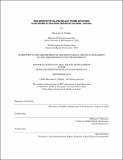The effects of oil prices and other economic indicators on housing prices in Calgary, Canada
Author(s)
Padilla, Mercedes A. (Mercedes Angeles)
DownloadFull printable version (1.661Mb)
Other Contributors
Massachusetts Institute of Technology. Dept. of Architecture.
Advisor
William C. Wheaton.
Terms of use
Metadata
Show full item recordAbstract
This thesis aims to answer: (1) to what extent can oil prices and other economic indicators predict the changes in housing prices and rent in the Calgary single family housing market and (2) to determine what the lag time is between them. Implications of this study from a macro perspective are multiple. This study can be used as a simplified case study in isolating the effects of the boom and bust cycles of economic industries and quantify its impact to real estate performance. Results found an astonishing correlation. Oil prices, exchange rate, interest rate and employment levels can determine up to 98% of the changes in house prices and rents. Oil prices, representing economic viability of the city, affect the real estate industry with a lag of 7 quarters of approximately two years, while interest rates representing the financial well-being of the city affect house prices and rents with a lag of 2 1/2 years. Foreign exchange rate to the dollar, representing the relative global prosperity, affects real estate prices in one year. House prices seem to be equally sensitive to a positive or negative shock in oil prices, exchange rate, and interest rates. At which, $25/barrel oil price seems to be the "breakeven" level at which house prices remain stable, all else equal. (cont.) Above which, prices will continue to appreciate, below which, prices will fall. Not surprisingly, this is the same estimate of the "breakeven" point at which the oilsands in Calgary become economically viable. Rents are more sensitive to positive shocks in oil prices, not exchange rate. Inversely, they sensitive to negative shocks in exchange rate, not oil prices. Rents are not sensitive to interest rates.
Description
Thesis (S.M.)--Massachusetts Institute of Technology, Dept. of Architecture, 2005. This electronic version was submitted by the student author. The certified thesis is available in the Institute Archives and Special Collections. Includes bibliographical references (leaves 48-49).
Date issued
2005Department
Massachusetts Institute of Technology. Department of ArchitecturePublisher
Massachusetts Institute of Technology
Keywords
Architecture.